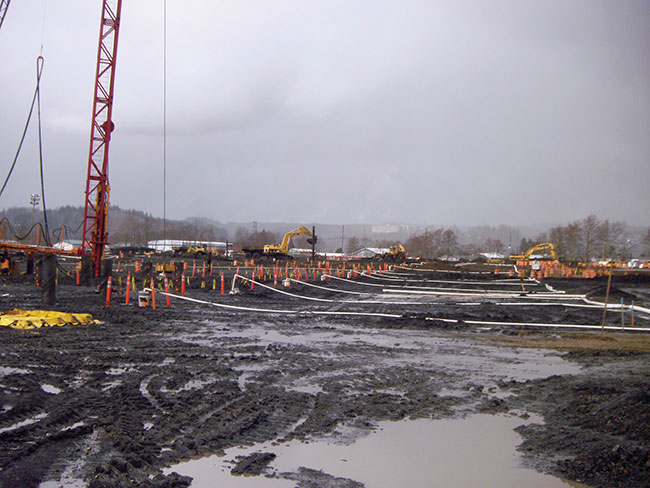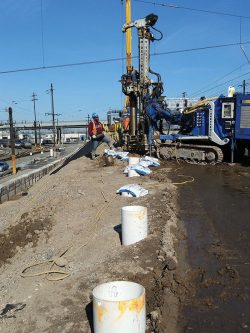
Dewatering Construction Sites
By Richard Gurberg
Features Supplier stories canada dewatering rental tipsUnderstand site dewatering to offer better advice..

In Canada, there is a joke that there are only two seasons: winter and construction. Though construction continues at a good pace in many parts of Canada under normal winter conditions, the arrival of spring every March means construction projects can be built quicker and easier as the snow melts and the ground thaws.
Spring also marks the beginning of Canada’s flood season. As temperatures rise, above average snowpack and heavy rainfall can increase the possibility of flooding due to snowmelt and runoff causing overflow in flood-prone areas, especially where the water table is high. For these reasons and more, nearly all construction sites need to carry out dewatering processes to remove water accumulation and/or temporarily lower the water table so that construction can take place.
Construction dewatering refers to the process of removing water from an excavated site, such as a foundation pit for a home or building, when it is located below the groundwater table, or when constructing in a wet area. The purpose of dewatering is to keep the excavation dry so that concrete footings and other foundation work can be properly completed. Dewatering also keeps the workplace dry and safe for construction crews since a muddy work site presents a slipping hazard for both people and machinery, and accumulated water near electrical equipment poses a safety risk.
Besides creating a dangerous work environment for crew members, uncontrolled groundwater can cause floods in excavated areas, damaging construction equipment and materials, causing trench collapses and compromising the structure that is being built. Dewatering can be costly and time-consuming, but the damages resulting from failing to remove the water or putting in preventative measures are almost always worse. Having a dewatering plan is an effective way to help keep the construction project within budget and on schedule by ensuring concrete foundations and footings are kept dry so they set properly. It also helps avoid on-site accidents due to mud and slick conditions.
Dewatering Best Practices
When developing a dewatering plan, it is important to consider that each site is a unique environment with its own specific challenges, so there is no “one-size-fits-all” approach. It is best to perform a site-specific evaluation, including assessing historical data if available, and local records of the area to gain a deeper understanding of the groundwater behaviour. If possible, consult with a ground engineering specialist or other experienced professionals with dewatering expertise who can help assess specific project needs and recommend the best solution at an efficient cost.
In any dewatering application, the following best practices should be mandated:
- Perform an analysis of the water table conditions within the area before beginning any dewatering processes.
- Choose an appropriate discharge location, paying close attention to follow local, provincial and federal requirements and best construction management practices when groundwater will be discharged to wetlands, lakes or directly to sewer inlets.
- Do not discharge groundwater that has been contaminated with grease, oil or chemical products to prevent environmental pollution and avoid legal noncompliance.
- Monitor for signs of soil erosion, such as cracks in the soil and overhangs, and discontinue dewatering if the area shows signs of instability.
- Choose discharge water channels that are stable and heavily vegetated, if possible, to help reduce soil erosion.
- Avoid pumping groundwater directly into slopes to prevent rapid erosion.
- Check with your municipal, provincial and/or federal agencies regarding additional requirements or specific permits that may be needed.
Dewatering Applications
In addition to residential and commercial construction sites, dewatering is also performed for concrete repair jobs; pipeline projects; mining applications; pond or lake excavations for making stormwater management systems; and in the installation and maintenance of utility lines such as sewers, water, telecommunications and electricity. In the aftermath of natural disasters such as floods and storms, emergency dewatering solutions can help to quickly counter the damage wrought on these areas by devastating floodwaters.

There are five main methods of dewatering construction sites: sump pumps, wellpoints, eductor wells, deep wells and inflatable cofferdams.
Dewatering Techniques
There are five main methods of dewatering construction sites: sump pumps, wellpoints, eductor wells, deep wells and inflatable cofferdams. Other methods may include siphoning or using large construction machinery buckets to scoop and dump water, though these techniques are typically reserved for smaller projects.
1. Sump pumps
Sump pumping is the most common dewatering practice. This method uses gravity to collect groundwater in sumps as the water seeps down into the excavation areas and then it is pumped out to the discharge location. There are different types of sump pumps depending on the volume of water needing to be removed and the soil type. For example, if the groundwater is mixed with a lot of silt, a pump with hardened components or coatings might be the better choice.
2. Wellpoint
Wellpoint systems use a series of drilled wells which are aligned alongside the excavated areas. The wells are connected at riser pipes (or dewatering pipes), which are connected to a flexible swing pipe on the surface. A common header pipe connects the entire system, and a vacuum pump at one end of the header pipe uses suction to draw the groundwater up to be discharged away from the excavation site. Wellpoints are best suited for excavation depths of five to six meters and can be installed in a wide variety of soils including sands, silts, soft clays, gravels and stratified soils.
3. Eductor wells
Eductor wells are similar to wellpoint systems, however they rely on high-pressure water rather than a vacuum to draw the water. Eductor wells are effective for situations in which pumping levels are too deep for wellpoints. These systems require a high-pressure supply line at the head of the well and a low-pressure return line. Often, installation, monitoring, control and maintenance experience is required to operate eductor well systems at maximum performance and efficiency. While more costly to install than wellpoint systems, they typically have a lower operating cost and are more scalable.
4. Deep wells
In situations where the water table needs to be lowered to depths of up to several hundred meters, deep wells are commonly used for site dewatering and are created by drilling boreholes around the excavation area. Deep wells are often used with a submersible pump which extracts the groundwater via discharge lines, lowering the groundwater level to the project’s desired depth. Once the boreholes are drilled, casings are used to stabilize and retain the bored wells. Deep wells are mostly used for projects where large amounts of water need to be pumped away from the excavation site, for example, tunnels and dam building.
5. Inflatable cofferdams
Inflatable cofferdams are water-inflated barriers used for dewatering and/or restricting water from re-entering excavation sites during construction. Unlike traditional cofferdams, which simply hold water away from a work area and are typically used in conjunction with a sump pump or some form of well, a water-inflated dam pumps the on-site water into itself. As it fills with water, the internal baffle system stabilizes to make a 45-degree forward lean, creating a watertight seal along the surface. Water-inflated cofferdams are constructed from industrial grade vinyl-coated polyester, which is extremely durable, making these devices suitable for various conditions and terrain. They are also reusable, and the size can be customized to suit the application, making them a highly cost-effective and sustainable option. Their versatility and the ease with which they are stored, transported and installed also make them a great do-it-yourself solution for general contractors, further helping to save costs. Water-inflated cofferdams are essential for dewatering shallow excavation sites and for use as a flood protection tool to keep residential and commercial properties safe from damaging floodwaters.
At the end of the day, establishing a dewatering plan and choosing reliable dewatering systems are crucial to maintaining a construction project’s critical path. Without a dry worksite, concrete pouring is halted, equipment and materials can become damaged, and working conditions are made hazardous. Dewatering allows work to proceed in dry conditions, with better precision, quality and as much safety as possible.
Richard Gurberg is president and owner of Creatium Equipment, a Canadian distributor of flood protection and water control solutions.
Print this page
Leave a Reply